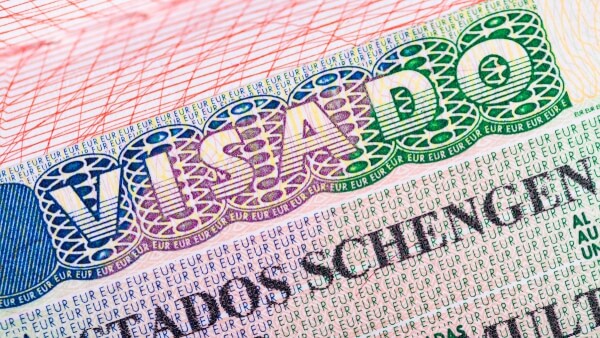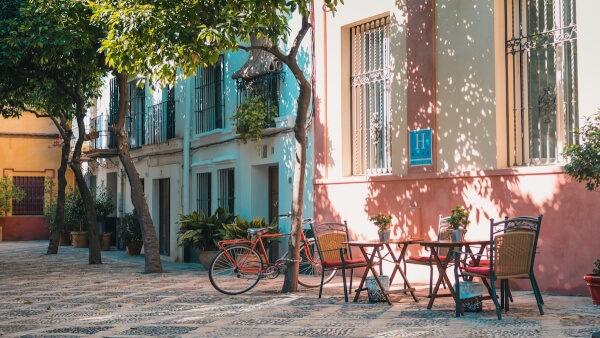Is it better to use cash or card in Spain?
Should you pay with cash or card in Spain? A handy guide including cash etiquette, Spanish ATMs and using your UK card.

Key takeaways:
Whether you plan to kick back on the beaches of Barcelona, see phenomenal works of art in the many museums of Madrid, or snack on savoury tapas in Seville, this guide is here to help you have a memorable (and safe) trip to Spain. We’ll lay out the key info on visa and entry requirements, health and safety essentials, laws and currency, money and customs and much more.
We’ll also show you a convenient and cost-effective way to spend in Spain – the Wise debit card. It’s designed for low-cost spending in 150+ countries. This clever international debit card automatically converts your pounds to Euros whenever and wherever you spend, for low, transparent fees* and mid-market exchange rates.
Learn more about the Wise debit card 💳
Before you travel to Spain from the UK, you’ll need to know about the country’s entry requirements for UK nationals.1
Luckily, as with all Schengen Zone countries, you won’t need to apply for a visa in advance, and can stay in Spain up to 90 days within a 180-day period. That means that you’ll need to keep evidence of when you arrived, whether that’s a stamp in your passport or printed out plane tickets.
This 90-day window applies not only to visits for tourism purposes, but also visiting friends and family, attending business meetings, cultural or sports events or short term studies or training.
Under the Schengen Area Rules, your passport will also need to have a ‘date of issue’ less than 10 years before the date you arrive. It should also have an ‘expiry date’ of at least three months after you plan to leave the Schengen Area.
Border control agents might also ask you to show a return or onward ticket as well as proof of travel insurance or that you have enough money for your visit.
Spain is generally considered to be a safe place to travel, provided that you take some common sense precautions.
In terms of safety risks, there are a few things you’ll need to know about. According to the UK Government’s Foreign, Commonwealth and Development Office (FCDO), there is a risk of terrorism attacks, especially in areas frequented by a lot of tourists. Note, however, that they give this advice for most European countries, so it’s not Spain-specific.
Drivers should be aware of ‘highway pirates’, who tend to go after foreign-registered and hire cars, especially those towing caravans. They could flag you down, claiming there’s something wrong with their car or that you damaged theirs.
Furthermore, the FCDO advises travellers to be vigilant about belongings, especially at airports and in crowded areas, and to not carry all of your valuables in one place. Be sure to have a copy of your passport with you.
While not common, drink spiking does occur, so be sure to keep an eye on any drink you order. Stay within your limits as well, as many drinks in Spain tend to be stronger than in the UK.
Between the warmer months of April to October, there is also a high risk of wildfires.2

All around Spain, you’ll be able to pay with Euros. You can either exchange your British pounds directly, take money out of an ATM, pay with a debit or credit card or use mobile payment options such as Apple Pay.
You can change your British pounds for Euros in the UK, or when you arrive in Spain. Just make sure to get a fair exchange rate by watching out for added fees/commission, which can be steep at airports or hotels.
Spending on a debit or credit card is also an option. Spain has plenty of ATMs, especially in larger cities and the centres of smaller towns and villages. You’ll find them by the name *cajero automático, or caixer *in Catalan.
However, many UK credit cards charge a transaction fee of around 2.75 to 2.99 percent for purchases made in foreign currencies.3
Avoid getting hit with high fees and poor exchange rates at airports and other exchange houses by using the Wise debit card. You’ll then be able to spend in 40+ currencies by automatically converting your pounds at the mid-market exchange rate, only adding a tiny currency conversion fee* – or it’s free if you already have the local currency in your Wise account.
According to the Bank of Spain, cash is still the country’s most common payment method, although a growing number of businesses accept card payments.4
You can pay with your UK contactless card, as well as with Apple or Google Pay, which over 90 percent of card terminals in Spain support.5
You can also use your Wise card or Wise virtual card for contactless payments in Spain.
If you withdraw money from an ATM, fees tend to be pretty cheap at €0.50 to €0.80 EUR per transaction (approx. £0.42 to £0.68).6 But some cash machines come with fees as high as €6 (approx. £5.07).
Flight costs from the UK to Spain vary quite a bit depending on whether you fly direct, during the high season, or take a major route.
The timing during the week also matters, with booking comparison website Skyskanner listing Wednesday-Wednesday flights as significantly cheaper than those departing and returning at the weekend.
Roundtrip costs could range from £30 for a direct flight with a budget airline like Ryanair or easyJet -- or a major airline with long layover -- in the off-season, to £500 for a direct flight in August.
A slightly off-season roundtrip flight from London Stansted (STN) to Madrid (MAD), departing on Sunday and returning on Sunday, costs £53 with budget airline Ryanair. The same flight, heading out of London Heathrow (LHR) with British Airways, will set you back £140.
A direct flight at the same time from Manchester (MAN) to Barcelona (BAR) will cost as little as £63 with the Spanish low-cost airline Vueling or £175 with British Airways.7
We’ll also take a look at the general travel costs you can expect across three major cities and regions in Spain, with a focus on accommodation at a mid-range hotel, the *Menu del día *-- a large lunchtime menu which comes with two plates and a drink or dessert -- and public transport.7
| Category | Madrid | Barcelona | Andalusia region |
|---|---|---|---|
| Accommodation | £75–110 | £85–130 | £60–95 |
| Transport | Metro £1.25–1.70 per ride; 10 trips ~£10.40 | Metro £2 per ride; 10-ride card ~£9.65 | City buses £1.20–1.30; regional trains cheap if booked early |
| Food & Drink | Menu del día £10–13; coffee £1.25; tapas ~£2.50 | Menu del día £11–14; tapas £2.50–3.50; coffee £1.70 | Tapas £1.70–2.50; Menu del día £8–10; Granada famous for free tapas |
| Main sights | Prado Museum, Royal Palace, Retiro Park, lively nightlife | Sagrada Família, Park Güell, Gothic Quarter, city beaches | Alhambra (Granada), Mezquita (Córdoba), flamenco in Seville, Costa del Sol beach |
Spain is generally an affordable destination for tourists from the UK. There are a few hidden costs to keep in mind, however, to keep your daily expenditures from adding up too fast.
| 🇪🇸 Read more: Spain tourist tax - what you need to know |
|---|
When you travel to Spain from the UK, you can expect the rules to differ a bit from those back home. Below are some essential ones to look out for.
If you experience an emergency situation during your trip, these are the numbers to call:
If in doubt, you can call 112, which operates 24/7 and can be used for all types of emergencies.
Be sure to keep the contact of your travel insurance provider handy in case you need to make a claim or require assistance.11
Open a Wise account online and you can order the Wise debit card for a one-time fee of £7. You can use this clever card in 150+ countries, including Spain.
It automatically converts your pounds to local currency whenever you spend using the mid-market exchange rate, only adding a tiny, transparent conversion fee* – or it’s free if you already have the local currency in your Wise account.
Here are some of the most common questions:
After Brexit, UK phone carriers were no longer required to offer roaming services for free in the EU. Many still do up to a certain amount of data or roaming plan, however. O2 for example offers free EU roaming for up to 25 GB per month12 whereas Vodafone UK gives you the option to pay around £2 extra per day.13 Alternatively you can get an eSim card to avoid roaming charges.
In order to use your electronics in Spain, you’ll need a Type C or Type D plug adapter.
While UK residents are not legally required to have travel insurance for Spain, taking out a policy is still highly recommended. Your GHIC (Global Health Insurance Card) grants access to state-provided healthcare in Spain but still doesn’t cover private medical treatment, emergency repatriation to the UK or trip cancellations, lost baggage or delays.14
Sources used:
Sources last checked on 22-Sept-2025.
*Please see terms of use and product availability for your region or visit Wise fees and pricing for the most up to date pricing and fee information.
This publication is provided for general information purposes and does not constitute legal, tax or other professional advice from Wise Payments Limited or its subsidiaries and its affiliates, and it is not intended as a substitute for obtaining advice from a financial advisor or any other professional.
We make no representations, warranties or guarantees, whether expressed or implied, that the content in the publication is accurate, complete or up to date.

Should you pay with cash or card in Spain? A handy guide including cash etiquette, Spanish ATMs and using your UK card.

Travelling to Spain and need cash? Our guide to ATMs in Spain, will help you locate them, explain fees, exchange rates, withdrawal limits and more.

Are you applying for a Spanish visa from the UK? Here's what you need to know, plus how to save on fees and avoid bad exchange rates with Wise.

Read our essential guide to using Amex in Spain, including fees, exchange rates, tips and where American Express is accepted in Spain.

Travelling to Spain soon? Find out everything about the tourist tax in Spain and essential travel tips.

Check out our in-depth guide on everything you need to know about buying a prepaid Spain SIM card, including different providers, pricing, and features.